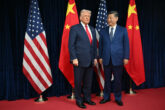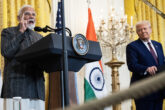June 18, 2020
How to Prevent a War in Asia
Amid all the uncertainty about the world that will follow the pandemic, one thing is almost sure to be true: tensions between the United States and China will be even sharper than they were before the coronavirus outbreak. The resurgence of U.S.-Chinese competition poses a host of challenges for policymakers—related to trade and economics, technology, global influence, and more—but none is more consequential than reducing the risk of war. Unfortunately, thanks to today’s uniquely dangerous mix of growing Chinese assertiveness and military strength and eroding U.S. deterrence, that risk is higher than it has been for decades, and it is growing.
Neither Washington nor Beijing seeks a military conflict with the other. Chinese President Xi Jinping and U.S. President Donald Trump both undoubtedly understand that a war would be disastrous. Yet the United States and China could all too easily stumble into conflict, sparked by a Chinese miscalculation of the United States’ willingness or capability to respond to provocations in disputed areas such as the South China Sea or to outright aggression against Taiwan or another U.S. security partner in the region.
Read the full article in Foreign Affairs.
More from CNAS
-
Indo-Pacific Security / Energy, Economics & Security
How to Win the Economic War with ChinaTrump's approach to China has run aground, giving Beijing unprecedented advantage in the economic conflict....
By Edward Fishman & Julian Gewirtz
-
America’s Self-Loathing Is a Losing Hand
This article was originally published in The Washington Post.Around 10 years ago, the United States began a historic shift in its grand strategy toward China, abandoning the b...
By David Feith
-
Indo-Pacific Security / Energy, Economics & Security / Technology & National Security
Selling AI Chips Won’t Keep China Hooked on U.S. TechnologyU.S. policy should not rest on the illusion that selling chips can trap China inside the American tech ecosystem....
By Janet Egan
-
Will New Delhi-Beijing Move Beyond Friction Points? | Ex-White Official On India-China Reset
Prime Minister Narendra Modi on Friday said that India and China, as two major economies, must work together to bring stability to the global economic order. NDTV's Gaurie Dwi...
By Lisa Curtis




